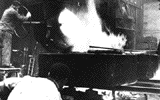Victor Hugo
There, in the forests, at the feet of the brown and hairy occidental hills, two round fire pupils explode and glow as tiger’s eyes.
Here, by the roadside, is a scaring 80 feet high candlestick, burning in the landscape and throwing sinister reflections on the rocks, the forests and the ravines.
Further away, at the entrance of this valley buried in shadows, there’s a mouth full of live coals that opens and closes itself quickly, and from which exits from time to time a flame tongue, with horrible hiccups.
These are the plants lighting up.
When you are beyond the place called « La Petite Flémalle », this thing becomes inexpressible and truly wonderful. The whole valley seems cut by erupting craters. Some discharge whirlwinds of scarlet vapour studded with sparks behind the copses; some other gloomily sketch the black silhouette of the villages on a red backdrop; elsewhere the flames appear through the cracks of a group of buildings.
It’s as if an enemy army had just marched through the country, and twenty pillaged villages offer you all the aspects and phases of a fire in this dark night, some burning, some smoking, some other blazing. This war sight is given by peace; this horrible copy of devastation is done by industry. You just have M. Cockerill’s blast furnaces in front of your eyes.
Victor Hugo, 1838-1839
in Industria - Architecture industrielle en Belgique
